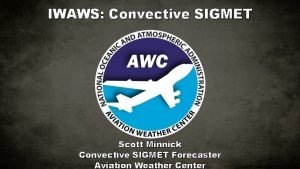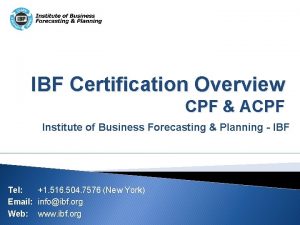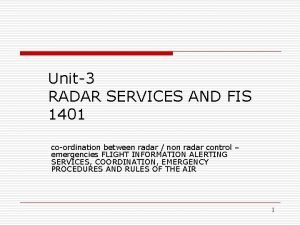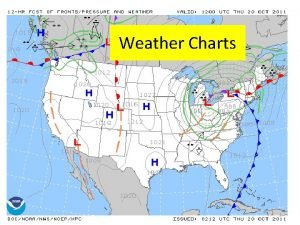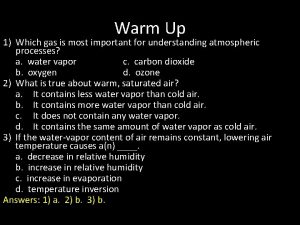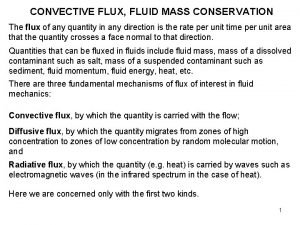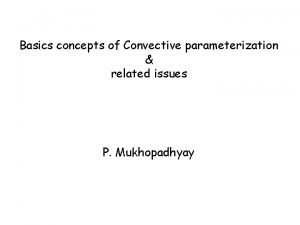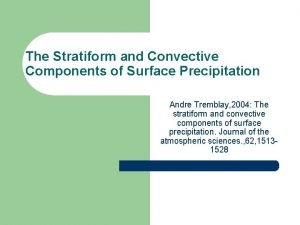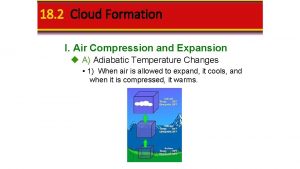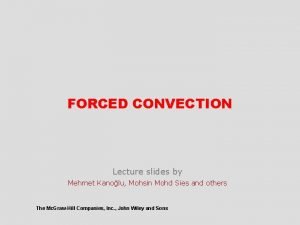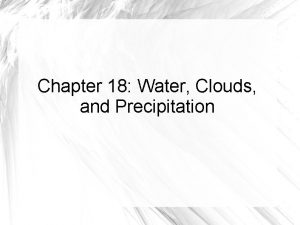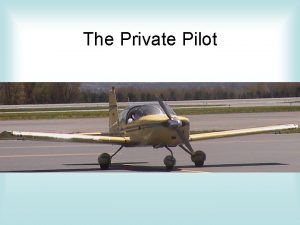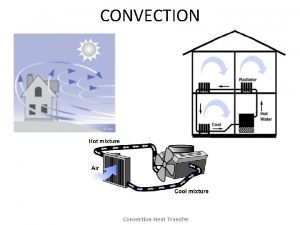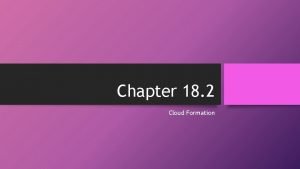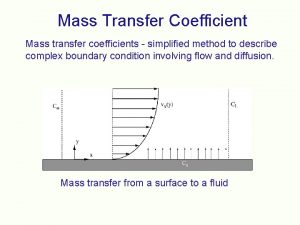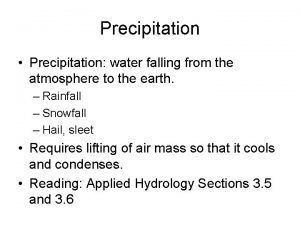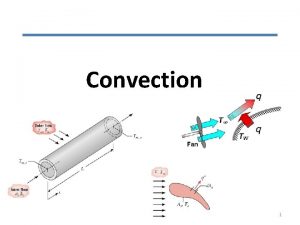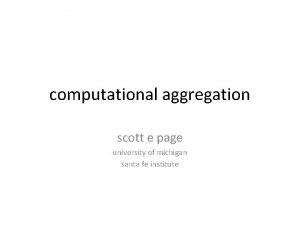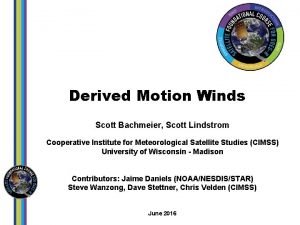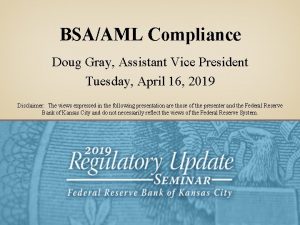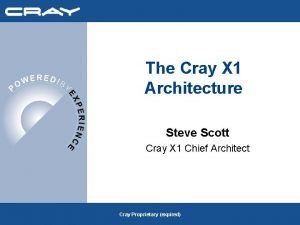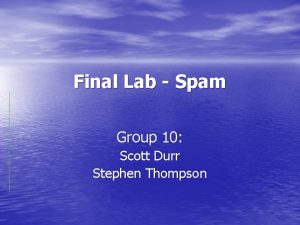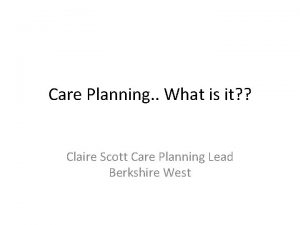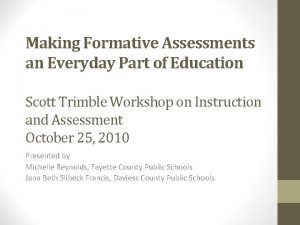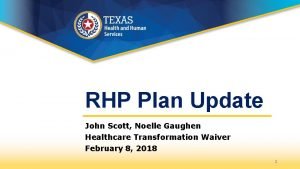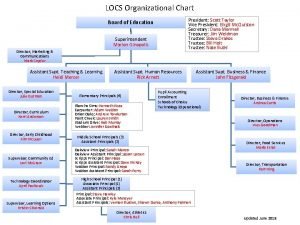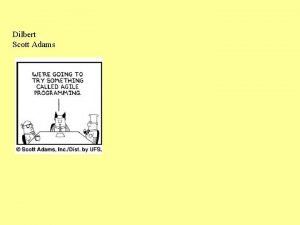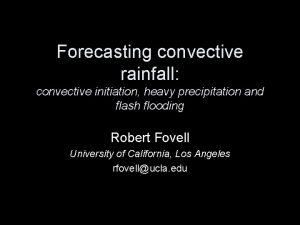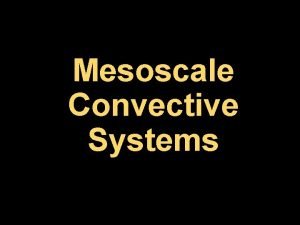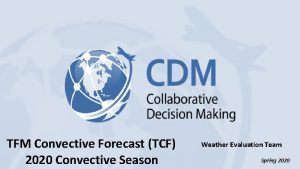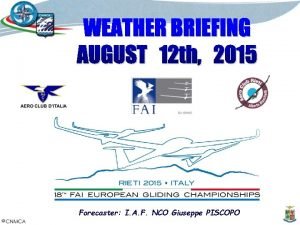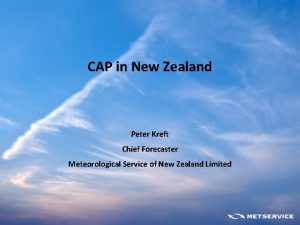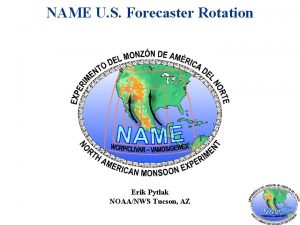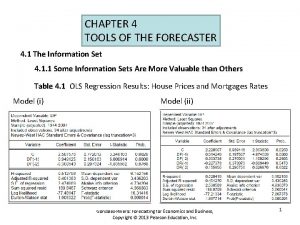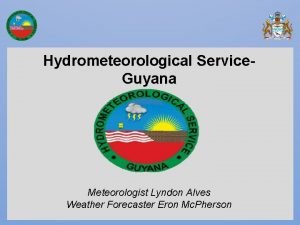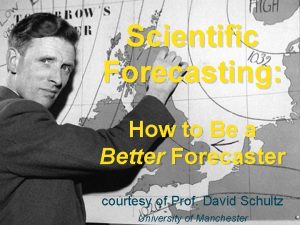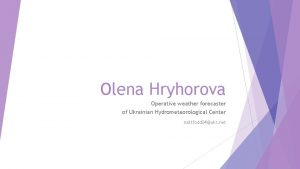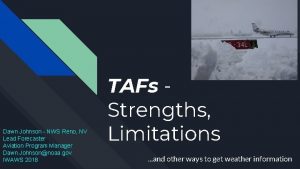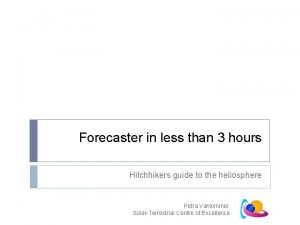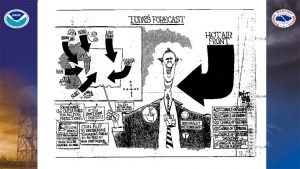IWAWS Convective SIGMET Scott Minnick Convective SIGMET Forecaster





























- Slides: 29

IWAWS: Convective SIGMET Scott Minnick Convective SIGMET Forecaster Aviation Weather Center

Thunderstorm Impacts Q Loss of Control (LOC) events remain one of the leading causes of aircraft accidents. -NTSB Q Weather accounts for ~38% of LOC events. –NTSB Q Adverse Winds Q In-flight Icing Q Thunderstorms Q In an effort to warn pilots of dangerous thunderstorms, the AWC’s convective SIGMET forecaster monitors thunderstorm activity to protect life and property.

What is a Convective SIGMET? Convection: Q Rising air due to surface heating that results in the development of clouds and thunderstorms. SIGMET: Q Significant Meteorological Information which is an advisory on significant meteorological phenomena that concern the safety of airspace and aircrafts. Convective SIGMET= Inflight weather advisory to advise aircraft of hazardous weather.

Convective SIGMET Background Q The convective SIGMET desk began after Southern Airways flight 242 crashed while flying into an area of severe thunderstorms during the late afternoon of April 4 th 1977. Q While enroute from Huntsville to Atlanta, GA, it entered a severe thunderstorm over Rome, GA while cruising between FL 140 to FL 170. After both engines failed and couldn't be restarted an emergency landing was attempted on State Spur Highway 92. Of the 85 persons aboard Flight 242, 62 were killed, 22 were seriously injured, and 1 was slightly injured. One passenger died on June 5, 1977. Q Additionally, eight persons on the ground were killed and one person was seriously injured; the injured person died about 1 month after the accident all totaling 72 fatalities. The aircraft was destroyed. (NTSB)

AWC Thunderstorm Definitions Q Severe Thunderstorm: Q Produces tornadoes, hail of 3/4 -inch diameter or larger, and/or wind gusts of 50 knots (58 mph) or greater. Q Embedded Thunderstorm: Q Occurring within and obscured by haze, stratiform clouds, or precipitation from stratiform clouds. Q Line of Thunderstorms: Q A line is at least 60 miles long with thunderstorms affecting at least 40 percent of its length. Q Area of Thunderstorms: Q Affecting at least 3, 000 square miles (1 deg Lat Lon square) Q Isolated Thunderstorm: Q Refer to single cell thunderstorms with a diameter less than 40 miles. (Can use forecaster judgment for cells greater than 40 miles. )

Convective SIGMET Criteria QConvective SIGMETs are advisories consisting of an observation, including a 2 -hour trend forecast and remarks. It is a description of phenomena compiled from radar reports, satellite and lightning data, Pilot Reports (PIREPs), or other reports. Convective SIGMET forecasters are given discretion to satisfy the criteria below: Q A Convective SIGMET is issued when one or more of the following is expected to be met for more than 30 minutes: Q A line of thunderstorms at least 60 miles long with thunderstorms affecting at least 40 percent of its length. Q An area of active thunderstorms affecting at least 3, 000 sq. miles covering at least 40 percent of the area concerned and exhibiting a very strong radar reflectivity intensity or a significant satellite or lightning signature. Q Embedded or severe thunderstorm(s) expected to occur for more than 30 minutes during the valid period regardless of the size of the area. Q NWSI 10 -811

Line of Thunderstorms Q A line of thunderstorms at least 60 miles long with thunderstorms affecting at least 40 percent of its length. Line

Area of Thunderstorms Q An area of active thunderstorms affecting at least 3, 000 sq. miles covering at least 40 percent of the area concerned and exhibiting a very strong radar reflectivity intensity or a significant satellite or lightning signature. --+-+--+ ----+-+ - ----+-+----+--++ ----+ +--+ - Area

Embedded or Severe Thunderstorm(s) Q Embedded or severe thunderstorm(s) expected to occur for more than 30 minutes during the valid period regardless of the size of the area. Q Aren’t all thunderstorms severe to pilots? Q Strong updrafts loft hail high into the thunderstorm Q Severe Turbulence and icing are implied. Q Watches are referenced in the outlook text. Q Valid SIGMETs are not updated to add severe wording. Q American Airlines Flight 1897 Severe

Special Issuance Criteria Q A special Convective SIGMET may be issued when any of the following criteria are occurring or, in the judgment of the forecaster, are expected to occur for more than 30 minutes of the valid period: Q A Tornado, hail greater than or equal to 3/4 inch, or wind gusts greater than or equal to 50 knots are reported. Q Indications of rapidly changing conditions, if in the forecaster’s judgment, they are not sufficiently described in existing Convective SIGMETs. Q Special issuance is not required for a valid Convective SIGMET.

Issuance Time and Valid Period Q Three (3) Convective SIGMET bulletins for the eastern, central and western regions of the CONUS will be issued hourly on a scheduled basis. Q Convective SIGMETS are valid for 2 hours or until superseded by the next hourly issuance. Q A SIGMET bulletin must be transmitted each hour for each region. When conditions do not meet or are not expected to meet Convective SIGMET criteria within a region at the scheduled time of issuance a “CONVECTIVE SIGMET. . . NONE” message is transmitted.

Convective SIGMET Format Number Region Valid Time Areal Descriptor Description / Remarks States Outlooks and Valid Time Areal Descriptor

Convective SIGMET Format Q Text Representation: West Central East

Convective SIGMET CONVECTIVE SIGMET 12 E VALID UNTIL 1855 Z FL AND CSTL WTRS FROM 40 NE PIE-20 ENE SRQ-60 WSW SRQ LINE TS 30 NM WIDE MOV FROM 28015 KT. TOPS TO FL 410.

Convective SIGMET Outlook Q Outlooks are a planning tool Q 2 to 6 hour outlook where convective SIGMETs are possible. Outlook

Area of Responsibility Q One forecaster per shift covers the entire CONUS. Q Roughly 28, 000 Convective SIGMETs issued in 2017. Q 15 to 20 SIGMETs/hour is not uncommon. Q Up to 25 to 30 an hour possible.

Where Can I Find Convective SIGMETs? Q Aviationweather. gov/sigmet Q Click SIGMETs Tab Q Under Advisory Q Aviationweather. gov/gfa Q Under Tools

Things to Remember Q CSIG coverage Q 40% area and line Q Its an hourly product (issued at : 55) and valid for 2 hours Q CWSU’s can issue CWAs between the hour Q Forecaster discretion to issue a SPECIAL for rapidly evolving situations Q CSIG boxes are a snap shot and do not “move” with the storm Q Unlike severe thunderstorm warnings Q Motion is given in the text portion of the SIGMET Q Points are based on VHF Omnidirectional Range (VOR) Q Limited VOR points over coastal areas Q CSIGs are not updated if a severe weather warning is issued in an active SIGMET.

Radar Coverage and Latency Q Multi-Radar Multi-Sensor System (MRMS) Coverage Q Uses multiple radars to create a seamless radar product Q Better coverage, but. . . MRMS 1 km MRMS 4 km 9 km 3 D Mosaic https: //mrms. nssl. noaa. gov/

Radar Latency Q Radar Latency (delay): Difference in time between the radar image being created and the image getting to the user. Q Typically 4 to 6 minutes, but up to 15 minutes. Q Conditions can change rapidly during thunderstorm initiation. Q “Age indicator on NEXLAB indicates the age of the mosaic image created by the provider, not the age of the weather conditions. ” –NTSB Q On Dec. 19, 2011 a Piper broke up in flight near Bryan, TX. Q Pilot diverted to avoid weather but ended up in an area of developing showers. Q Nexrad updates were 4 -8 minutes old. Q Fast moving storms/Fast moving aircraft need quick information. Q Avoid thunderstorms by at least 20 nm. Dec. 19 Bryan, TX Plane Crash -CBS

Thunderstorm Climatology Q Thunderstorm Days Q Q Limited thunderstorm coverage west of the Continental Divide Winter: Fronts Summer: Monsoon High and associated moisture plume “Ring-of-Fire” Q Convective SIGMET Frequency Q Good topic due to infrequency of Convective SIGMETs in the West

-30 20 Da ys ays 20 D 10 - Thunderstorm Days

Convective SIGMET Frequency Q Percent of time that a 8 km grid cell had a CSIG during the month. October April March July September June August May Monthly CSIG Percent Frequency: 1999 -2004 NCEP/NCAR Reanalysis 500 mb Composite Mean Slemmer et al. 2004

Thunderstorm Frequency Hourly CSIG Percent Frequency During Conv. Season 1999 -2004 Slemmer et al. 2004

Tools Used Q Multi-Radar Multi-Sensor System(MRMS) Q Combines data streams from multiple radars, satellites, surface and upperair observations, lightning reports, rain gauges, and forecast models Q Produces a suite of decision-support products every 2 minutes. Q https: //mrms. nssl. noaa. gov/ Q Products: Reflectivity at Lowest Altitude (RALA) Composite Reflectivity Echo Tops (-18 d. Bz and -30 d. Bz) Vertically Integrated Ice (VII) Q Characteristics of the updraft Q -10°C Reflectivity Q Onset of Lightning Activity Q Q

Tools Used Q https: //www. star. nesdis. noaa. gov/GOES/index. php Q GOES-16 Q Q 16 different channels (2 visible, 4 near-infrared, 10 infrared) Red Band resolution: 0. 5 km (hi-res radar data 0. 25 km) CONUS scans every 5 minutes 2 meso scans every 1 minute Q GOES-17 coming late this year. Q Already seeing experimental products

Tools Used Q Geostationary Lightning Mapper Q First operational lightning mapper flown in geostationary orbit Q Detects the momentary changes in an optical scene, indicating the presence of lightning Q Measures total lightning (in-cloud, cloud-to -cloud, and cloud-to-ground) Q Resolution: 10 km Q AWC is the first National Center to use GLM operationally. Q Convective SIGMET and Tropical Desks Q Promising results vs. NLDN and Earth Networks

Pilot Reports (PIREPs) Q NTSB Forum June 21 -22, 2016 Q Several accidents noted where a PIREP may have provided critical information of the environmental conditions prior to the accident. We Want Your PIREPs

Thank You!! Q Contact: Q Scott Minnick Q scott. minnick@noaa. gov /NWSAWC @NWSAWC aviationweather. gov Q Acknowledgements: Q Q Q Amanda Martin Gregory Harris Jonathan Slemmer Brian Pettigrew Jesse Sparks Deb Blondin
 Iwaws
Iwaws Cpf certification
Cpf certification Radar control service
Radar control service Constant pressure analysis chart aviation
Constant pressure analysis chart aviation Localized convective lifting
Localized convective lifting Mass flux calculation
Mass flux calculation Cloud formation
Cloud formation Convective parameterization
Convective parameterization Stratiform
Stratiform Localized convective lifting
Localized convective lifting Nusselt number laminar flow in tube
Nusselt number laminar flow in tube Frontal wedging examples
Frontal wedging examples Clouds, fog, or dew will always form when
Clouds, fog, or dew will always form when Vertical
Vertical Section 18.2 cloud formation
Section 18.2 cloud formation Coefficient
Coefficient It is the water falling from the atmosphere.
It is the water falling from the atmosphere. Introduction to convection
Introduction to convection Scott e page michigan
Scott e page michigan Scott bachmeier
Scott bachmeier Walter scott lochinvar
Walter scott lochinvar Doug gray scott
Doug gray scott Steve scott cray
Steve scott cray Scott durr
Scott durr Claire scott planning
Claire scott planning Korey scott
Korey scott Open court reading program
Open court reading program Kwl formative assessment
Kwl formative assessment Scott noelle
Scott noelle Scott bearby
Scott bearby
